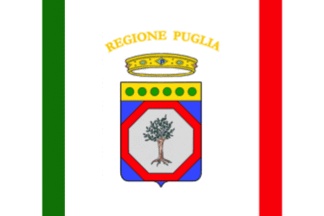 image by Roberto Breschi, 1 March 2020
image by Roberto Breschi, 1 March 2020
Last modified: 2020-06-19 by rob raeside
Keywords: italy | puglia | apulia | olive tree |
Links: FOTW homepage |
search |
disclaimer and copyright |
write us |
mirrors
 image by Roberto Breschi, 1 March 2020
image by Roberto Breschi, 1 March 2020
See also:
Other sites:
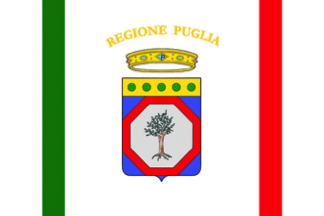 image by Roberto Breschi, 1 March 2020
image by Roberto Breschi, 1 March 2020
The gonfanon and arms of Region Apulia were originally prescribed by Regional
Law No. 28 ("Adoption of the coat of arms and gonfanon of Region Apulia"),
promulgated on 8 September 1988 by the President of the Regional Government and
published on 14 October 1989 in the Official gazette of the Italian Republic,
3rd Special Series - Regions, No. 41.
Article 2.
The coat of arms of
Region Apulia is composed of a Samnite shield and of a special gold crown. The
shield features an olive tree on a field argent framed in a red octagon bordered
in blue, as represented on the sketch in Appendix A, which is an integral part
of this law.
Article 3.
1. The Region's gonfanon is composed of a
rectangular cloth of 2 m x 1 m, white with two vertical stripes, green and red,
respectively, and the centered writing, in golden yellow, "Regione Puglia",
above the shield, as represented on the sketch in Appendix B, which is an
integral part of this law.
2. The display and use of the Region's gonfanon in
public events is exclusively restricted to cases prescribed by the laws of the
Republic.
3. The gonfanon shall be kept in the office of the President of the
Regional Council.
---
The flag of Region Apulia is prescribed by Regional Law No. 22, ("Adoption of
the flag of Region Apulia"), promulgated on 10 August 2001 by the President of
the Regional Government and published on 27 August 2001 in the Official gazette
of Region Apulia, No. 129, p. 7,437-7,439.
Article 1.
1. The flag of
Region Apulia is composed of a rectangular cloth charged in the center with the
Region's coat of arms, as prescribed in Regional Law No. 28 ("Adoption of the
coat of arms and gonfanon of Region Apulia") promulgated on 8 September 1988,
placed on a white background. The coat of arms' width is 3/5 of the flag's
height.
2. The width of the Region's flag is 2/3 of its length.
3. A
ribbon with the colors of the national flag is attached at the hoist's top.
4. The colors of the regional flag are those of the gonfanon and coat of arms
prescribed by Law No. 28.
Articles 2 to 5 contains the usual rules of use
and precedence of the flag
http://www.regione.puglia.it/documents/10192/5385672/bur-129.pdf/b10dce61-c4a8-486d-918e-0416d7c4b19a
Photo:
http://bandieredalvivo.com/Pagine%20regionali/Puglia.html
Ivan Sache, 1 March 2020
---
The present-day's symbols are prescribed by Regional Law No. 10,
("Modification of Appendices A, B and C of Regional Law No. 28 ("Adoption of the
coat of arms and gonfanon of Region Apulia"), promulgated on 10 May 2001 by the
President of the Regional Government and published on 12 May 2011 in the
Official gazette of Region Apulia, Supplement to No. 129, p. 6.
Article
1. To the coat of arms of Region Apulia and the regional gonfanon and seal, as
represented in Appendices A, B and C of Regional Law No. 28 ("Adoption of the
coat of arms and gonfanon of Region Apulia") promulgated on 8 September 1988, in
the upper part of the Samnite shield shall be added a sixth ring to represent
the sixth Apulian province, Barletta-Andria-Trani.
http://www.regione.puglia.it/documents/10180/4968866/N74+suppl_12_05_11.pdf
Strictly speaking, the new law does not amend the regional flag adopted
in 2011, but it probably does, de facto.
Ivan Sache, 1 March 2020
Official description of the coat of arms
"The emblem of Region Apulia
is composed of a shield surmounted by a "Frederickian" crown dedicated to
Frederick II of Swabia. The shield's chief features six circles representing the
six provinces forming Apulia. The main charge is composed of an octagon framing
an olive tree, a symbol of peace and fraternity. The octagon represents Castel
del Monte, a building of medieval origin that constitutes one of the most
emblematic landmarks of the region. The main colors of the emblem are or,
argent, red and sea blue."
http://www.regione.puglia.it/marchio-della-regione
Region Apulia website
The emblem highlights the strong connections between Apulia and Frederick II
(1194-1250), Holy Roman Emperor, King of Germany and King of Italy (1220-1250),
King of Sicily (1198-1250), and King of Jerusalem (1225-1228).
Frederick had
a personal interest for Apulia, which he considered as "the pupil of his eyes",
"a haven among the waves and a garden of delights among brambles". He further
wrote: "Among all other countries, We chose our possession in Sicily as our
reserved property; we made of the whole kingdom our palace and the privileged
place for Our stay, so that, while We shine with the glory of Caesar's title,
We, however, do not consider as outrageous to be named 'Man of Apulia'. Called
everywhere by the problems of the Empire, We consider Ourselves as a kind of
pilgrim who travels out of his own house, as long as We sail far from the courts
and ports of Sicily."
Apulia was the headquarter and stronghold of
Frederick II's Italian realms. From a strategic point of view, Apulia
constituted a convenient base for expeditions to North Italy and to watch Rome;
moreover, the landscape was pleasant and the abundance of game allowed the
emperor to practice his favorite hobby, falcon hunting.
Frederick visited
Apulia for the first time in 1221. He initiated in 1223 the building of a castle
in Foggia, which he turned into an imperial capital. Suppressed by an earthquake
in 1731, the castle was the place of munificent festivals, deemed by guests more
refined and extravagant than those already organized in Palermo, the main
capital of the Kingdom of Sicily.
Castel del Monte was described by the
German historian Ferdinand Gregoriovus (1821-1891) as "a pearl, as a symbol
visible from a distance, overlooking the infinite plain; people call it Apulia's
belvedere or balcony. Like a stone crown, the castle stands on a hill, which
appeared to me as the diadem of the Hohenstaufen empire, crowning a splendid
country, when sunset makes it shine in purpure and or."
Castel del Monte,
built in a strategic place, was mostly intended to convey feelings of admiration
and submission, if not fear, as a strong symbol of the imperial power.
The
octagonal design of the castle might have been inspired by monuments visited by
the emperor, such as the Byzantine basilica of San Vitale in Ravenna, the
Palatine chapels in Aachen and Haguenau, and the fortifications of the castle of
Eguisheim. Moreover, the octagon was a strong element of the Imperial symbolic,
featured in the Imperial crown and in Barbarossa's chandelier in Aachen. The
octagon is the ideal link between the circle, representing infinity, the
heavens, that is, the divine world, and the square, representing the four
compass directions, that is, the real world. Accordingly, the octagon represents
the Imperial ideology; the emperor is less than God but more than the man.
Oddly enough, Frederick II never stayed in Castel del Monte, which was used
only twice, as a jail in 1246 and for a princely marriage in 1249.
Lacking
ditches, drawbridges, stables and an arsenal, the castle would not have resisted
a siege and, therefore, had no military value. Castel del Monte, whose
architecture and design appear to be based on astrological and astronomical
considerations, is seen by historians as a personification of Frederick's power:
an "ecclesia imperialis" (imperial church), here a sacred monument of
profane essence.
[https://www.persee.fr/docAsPDF/bude_0004-5527_2000_num_1_1_1978.pdf
S. Haldenwang. 2000. Frédéric II et la Pouille. Bulletin de l'Association
Guillaume Budé, 1, 63-87]
Ivan Sache, 1 March 2020
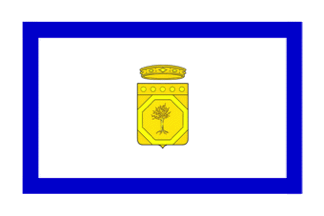 image by Roberto Breschi, 1 March 2020
image by Roberto Breschi, 1 March 2020
Adopted on 8 September 1988.
Pascal Vagnat, 22 September 1998
This flag is the flag of the President of the Council, of the
President of the regional government (Giunta) and of the members
of the regional assembly when the are taking part of official
events.
Pascal Vagnat, 2 May 2003
Article 8.
The President of the Council, the President of the Government
and the Representatives at the Regional Assembly attending to an official event
on the Region's territory shall use the distinctive flag represented on the
sketch in Appendix D, which is an integral part of this law.
https://www.gazzettaufficiale.it/eli/id/1989/10/14/089R0285/s3
Appendices are, unfortunately, not available in the electronic version.
Fortunately, Roberto Breschi provides a detailed description of the flag
prescribed in Article 8 and sketched in Appendix D.
"Proportions 2:3. White
with a blue rectangle, in thickness 1/20 of the flag's length and distant from
the flag's edge by 1/15 of the flag's length. Charged in the center with the
regional coat of arms, all or."
Breschi adds that the flag probably fell
into oblivion; while not formally abolished, it was replaced de facto in 2001
by the newly adopted regional flag.
Ivan Sache, 1 March 2020
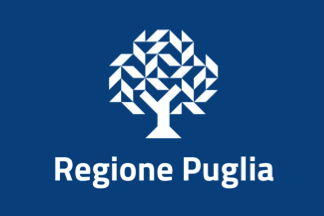 image by Ivan Sache, 3
March 2020
image by Ivan Sache, 3
March 2020
A proposal of Law "Modifying Regional Law No. 28 issued on 8 September 1988
("Adoption of the coat of arms and gonfanon of Region Apulia") and Regional Law
No. 22 issued on 10 August 2001 ("Adoption of the flag of Region Apulia") was
pushed in 2017 by Regional Councillor Vincenzo Colonna. This was indeed a
re-surfacing issue, since the original idea to change the symbols dates back to
2007. The document supporting the Bill recalls the historical background as
follows.
In 2007, the President of the Regional Government -
Institutional Communication Section impelled the action called "System of
coordinated and uniform image of Region Apulia. Base Action" aimed at "designing
a communication system that would be homogeneous, safe and promoting visual
identity". The elaboration of new distinctive emblems and of a new visual
identity was tasked to a working group chaired by Pr. Nunzio Perrone (Politecnico
Bari) and composed of diverse professors and experts of Politecnico Bari and
University of Bari.
The currently used coat of arms was designed in the
1970s by the Heraldry Service of the State Ceremony Office. Thirty years later,
the coat of arms is obsolete: esthetic sensibility has changed and its ability
to represent Apulia is questionable. Moreover, it is no longer suitable for
communication efficiency and reproduction via new technologies.
The striking
element of the coat of arms is the olive tree, an emblem with a high symbolic
value that conveys positive feelings and represent the people of Apulia, as once
written by Aldo Moro: "The olive tree has been highlighting for century, from
the Gargano promontory to the Salento peninsula, the laborious
life of sober, peaceful, courteous and friendly people. [...] it is the symbol
of the human quest by workers [...] with a tortuous trunk but crowned with
leaves and rich in fruits".
While an undoubted symbol of Apulia, the
olive tree has on the current coat of arms an excessively figurative
representation. The visual predominance of the trunk over the canopy, which is
rather sparse, conveys the idea of a not well-managed tree; the representation
of the roots evokes an uprooted tree. The representation of the tree presents a
contrast with other elements represented in a more abstract and evoking way,
such as the circles representing the provinces, the octagon (explicitly
referring to Castel del Monte), the sea's blue color, etc.
The heraldic
structure of the coat of arms is not compliant with the codes of heraldry. The
crown surmounting the Samnite shield is inappropriate, since the Regions were
set up later than Royal Decrees No. 651 and 652 issued on 7 June 1943, which
regulate the grants of crowns on such coats of arms. Moreover, Region Apulia is
the only Italian region to feature a crown on its arms.
Neither the Handbook
of Visual identity of Region Apulia, issued on 15 October 2013 by the Regional
Government , nor the modification of the arms prescribed in 2011 to account for
the newly created sixth province represent the present)day's Region.
The current
coat of arms is not suitable for digital representation. The details of the
olive tree and of the crown are hardly visible on small-sized representations of
the arms, making the emblem confusing and hardly legible.
The next part
of the documents illustrates the background elements presented above, adding
only one new, but highly significant element: the description of the
"excessively figurative" olive tree is dramatized: "the idea of a not
well-managed tree; the representation of the roots evokes an uprooted tree" is
completed as "the idea of a not well-managed tree and not healthy; the
representation of the roots evokes a dead tree. In the context of the Xylella
emergence, such a risk should certainly not be taken".
[It is, therefore,
highly probable, that the emergence of a lethal disease caused by the bacterium Xylella fastidiosa,
which killed thousands of olive trees in Salento, contributes to the
re-emergence of the emblem issue, which appeared to have been hitherto dormant.
First reported in October 2013, the olive quick decline syndrome (locally, olive
tree leprosy) has been killing since then more than one million trees in Apulia.
The emblematic value of olive tree (see above) and controversies about the
management of disease - since there is no cure, eradication of diseased trees
and quarantine measures are the only means of control - have caused the Xylella
crisis, a very sensitive issue in Apulia. The disease was not recorded anywhere
else in the world until the detection of two diseased trees on southern France
in September 2019. The disease represents a most serious threat for olive
cultivation in the Mediterranean Basin. Other crops, such as grapevine, citrus
and almonds, are also under threat, but by a bacterial subspecies different from
that attacking olive trees. The bacterium appears to be present on more than 200
wild and cultivated species, including ornamental plants, which makes
surveillance, and, mostly, communication with the public very tedious. Please
consult official sources and do not spread rumors and fake news!
http://www.emergenzaxylella.it/portal/portale_gestione_agricoltura Xylella
emergency files, Region Apulia
https://www.efsa.europa.eu/en/press/news/190515-0 European Food Safety
Authority files
https://ec.europa.eu/food/plant/plant_health_biosecurity/legislation/emergency_measures/xylella-fastidiosa_en
European Commission files]
The proposed new emblem features an olive tree
composed of black elementary triangles. The base is trapezoidal (a square
composed of four triangles flanked by two right-angle triangles composed of two
triangles), the trunk is rectangular (two squares each composed of four
triangles), and the two branches are rectangular (three square each composed of
four triangles, the whole rectangle slanted, the basal square common to the two
branches). The canopy is composed of 19 parallelogram (four triangles),
completed by a 7 right-angled triangles composed of two triangles.
The
resulting mosaic pattern is a metaphor of the plural identity of Apulia. Born
from this diversity, the olive tree represents a synthesis of the values of
modern Apulia. Moreover, the emblem is geometrically simple and modern.
The elementary triangles refers to the tripartite historical identity of Puglia:
- north: Daunia. Capitanata and Gargano (Province of Foggid):
- center:
Peucezia. Land of Bari (Provinces of Bari and BAT);
- south: Messapia. Fland
of Otrante and Salento (Provinces of Brindisi, Tarento and Lecce).
On the
self-standing emblem, the olive tree is placed on a slanted (45 degrees W)
rectangle (proportions 1:2) composed of four squares each composed of four
triangles, matching the map of Apulia (the protruding triangle representing
Gargano is omitted), therefore "a geographical synthesis" of Apulia. The white
tree can be placed on a blue, green or brown background. The hole is placed on a
white background, with the writing "Regione Puglia" in black letters (Titillium
font). The rectangle's lower corner is lined on the left edge of the "P" of
"Puglia".
The gonfanon of Region Apulia is a rectangular cloth of 1 m in
width on 2 m in length, blue (Pantone 3015), charged with the [vertically]
centered writing "Regione Puglia" surmounting the geometrically stylized olive
tree. The base of the flag is composed of two indentations (45 degrees) lined by
a fringe argent.
The flag of Region Apulia is a rectangular cloth of in
proportions 1.5 m in length on 1 m in width, blue (Pantone 3015), charged with
the geometrically stylized olive tree, surmounting the writing "Regione Puglia",
in white letter . The width and length of the olive tree shall have proportions
0.5, while the writing should have a length of 1 compared to the other measure
[indeed, the olive tree is inscribed In a square whose side is 0.5 of the flag's
width and the length of the writing is equal to the flag's width.].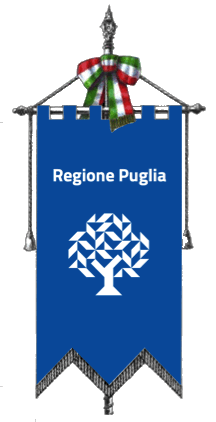 image by Ivan Sache, 3
March 2020
image by Ivan Sache, 3
March 2020
http://www5.consiglio.puglia.it/GISSX/XSagArchivio.nsf/(InLinea)/proposta-789A-X/$File/PdL_Segni_identificativi_della_Regione.pdf?OpenElement
Ivan Sache, 3 March 2020